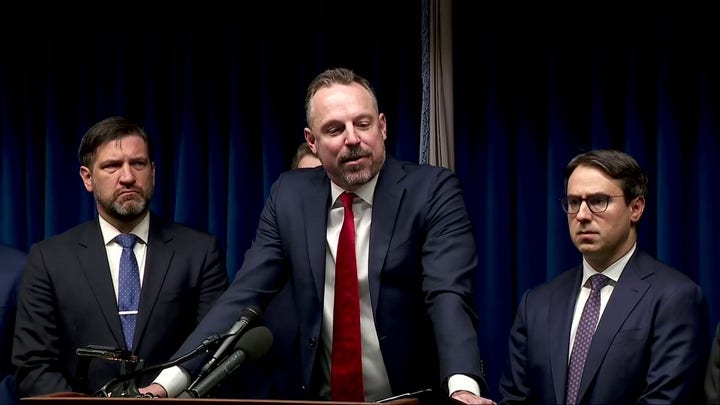PHOENIX, Ariz. – While it is true that Erika Kirk is head of one of the nation’s leading conservative groups, at one point this weekend at Turning Point USA’s AmericaFest, she made it clear that she holds an even more important title: mother.
After two days of infighting at the conference between some of its top stars, Kirk smiled on stage Friday night and said, ‘Well, say what you want about AmFest, but it’s definitely not boring. Feels like a Thanksgiving dinner where your family’s hashing out the family business.’
This is the best and most positive way to look at the squabbling in Phoenix between Ben Shapiro, Tucker Carlson, Megyn Kelly and other right-wing celebrities. It has been mostly over Israel, and it was a sideshow few attendees expected or particularly wanted.
Brent, in his 50s and from Oklahoma City, came to AmFest with his two sons.
‘I was in there the night Ben and Tucker went at each other, at one point, I told my wife, I’m going out for some air, I just felt like I needed to escape to the real world, you know?’ he told me over a smoke.
I did know.
Along with sniping over Israel and antisemitism, the question of what a ‘heritage American’ is, or if it is a thing at all, also spurred division. Ohio gubernatorial candidate Vivek Ramaswamy told the crowd, ‘I think the idea of a heritage American is about as loony as anything the woke left has actually put up,’ adding ‘There is no American who is more American than somebody else.… It is binary. Either you’re an American or you’re not.’
This would have been Civics 101, even for conservatives, not long ago, but Ramaswamy is right to mention wokeness, because proponents of the concept that a genealogy that leads back to nation’s founding is something special is mainly driven by such people being told for decades now that it is actually the only lineage that is not special, or something to be proud of.
I asked Dennis, who is the fourth-generation owner of a farm in South Dakota, which sounds pretty heritage-y to me, what he made of it all.
‘I don’t think much about that,’ he said. ‘If you love the country and follow the laws, you can be an American.’
Dennis was much more interested in, and comfortable talking about soybeans and sugar beets. I asked how the tariffs were affecting him, and he told me, ‘It’s hurt, but I look at the big picture and I think it will be good in the long run.’
It was tempting after speaking, not just with Dennis, but with many attendees, old and young, who are most focused on prices, to think, ‘It’s the economy, stupid, knock it off with the identity politics stuff.’ But Erika Kirk made a good point: These might be fights the right needs to have before settling into next year’s midterm elections.
TPUSA spokesman Andrew Kolvet posted on X with this very message.
‘If we force conformity without uncomfortable debates, there can be no winning consensus,’ he wrote. ‘There’s no civil war. This is the necessary work of a conservative coalition defining its dominant center ahead of the coming battles. We’re not hive-minded commies. Let it play out.’
It should also be noted how much better hashing all of this out at an actual live event is than endless sniping on social media where nobody is ever really forced to contend with ideas they oppose. The mere act of shaking hands with someone you disagree with can be a powerful calming influence.
On Sunday, the big finale of AmFest will be Vice President JD Vance’s speech to the assembled. As of 4 a.m., there was already a line for it.
Sarah, a college freshman told me, ‘I wasn’t old enough to vote for Trump, but I will get to vote for Vance, and I’m excited about that.’ This is good news for Vance, but it’s also a lot of pressure. Can he be the force that mends the wounds opening this weekend at AmFest?
Erika Kirk is right, families sometimes fight. In fact, sometimes they have to. But the question is always what happens after the blowup, after the tears and recriminations?
Rep. Anna Paulina Luna, R-Fla., told the crowd this weekend, ‘You may not like Tucker Carlson, Ben Shapiro, Steve Bannon or me. Guess what: If the radical left wins, we all hang together.’
This seems correct, and even after AmFest’s nasty internecine fighting, it is still a goal well within reach of TPUSA and the conservative movement. It is also almost certainly what Charlie Kirk would have wanted.



